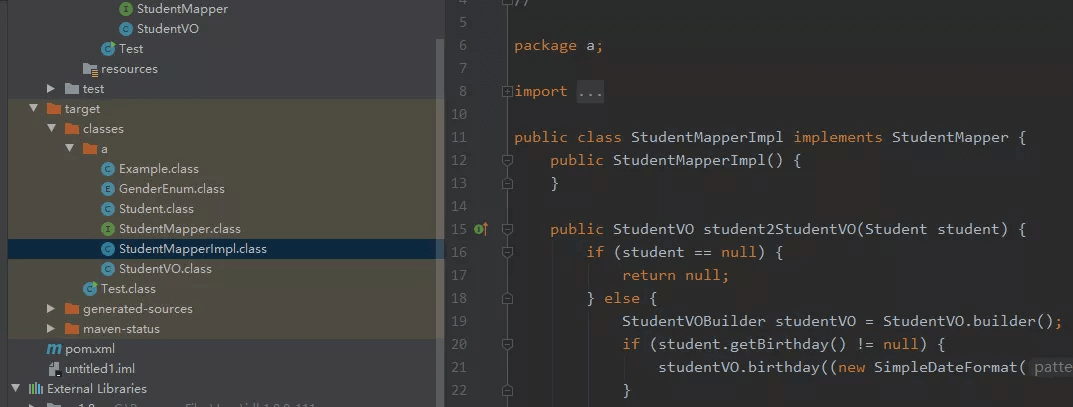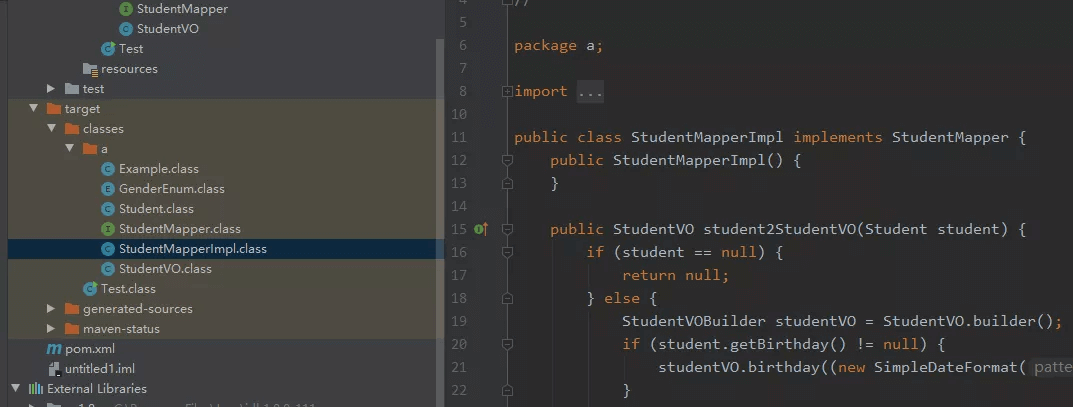Java MapStruct
官网地址:https://mapstruct.org/
pom 配置:
<properties><project.build.sourceEncoding>UTF-8</project.build.sourceEncoding><maven.compiler.source>1.8</maven.compiler.source><maven.compiler.target>1.8</maven.compiler.target><org.mapstruct.version>1.4.1.Final</org.mapstruct.version><org.projectlombok.version>1.18.12</org.projectlombok.version></properties><dependencies><dependency><groupId>org.mapstruct</groupId><artifactId>mapstruct</artifactId><version>${org.mapstruct.version}</version></dependency><!-- lombok dependencies should not end up on classpath --><dependency><groupId>org.projectlombok</groupId><artifactId>lombok</artifactId><version>${org.projectlombok.version}</version><scope>provided</scope></dependency><!-- idea 2018.1.1 之前的版本需要添加下面的配置,后期的版本就不需要了,可以注释掉,这里用的2019.3 --><dependency><groupId>org.mapstruct</groupId><artifactId>mapstruct-processor</artifactId><version>${org.mapstruct.version}</version><scope>provided</scope></dependency></dependencies><build><plugins><plugin><groupId>org.apache.maven.plugins</groupId><artifactId>maven-compiler-plugin</artifactId><version>3.8.1</version><configuration><source>1.8</source><target>1.8</target><annotationProcessorPaths><path><groupId>org.projectlombok</groupId><artifactId>lombok</artifactId><version>${org.projectlombok.version}</version></path><path><groupId>org.mapstruct</groupId><artifactId>mapstruct-processor</artifactId><version>${org.mapstruct.version}</version></path></annotationProcessorPaths></configuration></plugin></plugins></build>
关于lombok和mapstruct的版本兼容问题,maven插件要使用3.6.0版本以上、lombok使用1.16.16版本以上,另外编译的lombok mapstruct的插件不要忘了。否则会出现下面的错误:No property named “aaa” exists in source parameter(s). Did you mean “null”?
这种异常就是lombok编译异常导致缺少get setter方法造成的。还有就是缺少构造函数也会抛异常。
@Data@Builder@AllArgsConstructor@NoArgsConstructorpublic class Student {private String name;private int age;private GenderEnum gender;private Double height;private Date birthday;}public enum GenderEnum {Male("1", "男"),Female("0", "女");private String code;private String name;public String getCode() {return this.code;}public String getName() {return this.name;}GenderEnum(String code, String name) {this.code = code;this.name = name;}}@Data@Builder@AllArgsConstructor@NoArgsConstructorpublic class StudentVO {private String name;private int age;private String gender;private Double height;private String birthday;}@Mapperpublic interface StudentMapper {StudentMapper INSTANCE = Mappers.getMapper(StudentMapper.class);@Mapping(source = "gender.name", target = "gender")@Mapping(source = "birthday", target = "birthday", dateFormat = "yyyy-MM-dd HH:mm:ss")StudentVO student2StudentVO(Student student);}
实体类是开发过程少不了的,就算是用工具生成肯定也是要有的,需要手写的部分就是这个Mapper的接口,编译完成后会自动生成相应的实现类
然后就可以直接用mapper进行实体的转换了
public class Test {public static void main(String[] args) {Student student = Student.builder().name("小明").age(6).gender(GenderEnum.Male).height(121.1).birthday(new Date()).build();System.out.println(student);//这行代码便是实际要用的代码StudentVO studentVO = StudentMapper.INSTANCE.student2StudentVO(student);System.out.println(studentVO);}}

mapper可以进行字段映射,改变字段类型,指定格式化的方式,包括一些日期的默认处理。
可以手动指定格式化的方法:
@Mapperpublic interface StudentMapper {StudentMapper INSTANCE = Mappers.getMapper(StudentMapper.class);@Mapping(source = "gender", target = "gender")@Mapping(source = "birthday", target = "birthday", dateFormat = "yyyy-MM-dd HH:mm:ss")StudentVO student2StudentVO(Student student);default String getGenderName(GenderEnum gender) {return gender.getName();}}
1、List 转换
属性映射基于上面的mapping配置
@Mapperpublic interface StudentMapper {StudentMapper INSTANCE = Mappers.getMapper(StudentMapper.class);@Mapping(source = "gender.name", target = "gender")@Mapping(source = "birthday", target = "birthday", dateFormat = "yyyy-MM-dd HH:mm:ss")StudentVO student2StudentVO(Student student);List<StudentVO> students2StudentVOs(List<Student> studentList);}public static void main(String[] args) {Student student = Student.builder().name("小明").age(6).gender(GenderEnum.Male).height(121.1).birthday(new Date()).build();List<Student> list = new ArrayList<>();list.add(student);List<StudentVO> result = StudentMapper.INSTANCE.students2StudentVOs(list);System.out.println(result);}
2、多对象转换到一个对象
@Data@Builder@AllArgsConstructor@NoArgsConstructorpublic class Student {private String name;private int age;private GenderEnum gender;private Double height;private Date birthday;}@Data@AllArgsConstructor@Builder@NoArgsConstructorpublic class Course {private String courseName;private int sortNo;private long id;}@Data@Builder@AllArgsConstructor@NoArgsConstructorpublic class StudentVO {private String name;private int age;private String gender;private Double height;private String birthday;private String course;}@Mapperpublic interface StudentMapper {StudentMapper INSTANCE = Mappers.getMapper(StudentMapper.class);@Mapping(source = "student.gender.name", target = "gender")@Mapping(source = "student.birthday", target = "birthday", dateFormat = "yyyy-MM-dd HH:mm:ss")@Mapping(source = "course.courseName", target = "course")StudentVO studentAndCourse2StudentVO(Student student, Course course);}public class Test {public static void main(String[] args) {Student student = Student.builder().name("小明").age(6).gender(GenderEnum.Male).height(121.1).birthday(new Date()).build();Course course = Course.builder().id(1L).courseName("语文").build();StudentVO studentVO = StudentMapper.INSTANCE.studentAndCourse2StudentVO(student, course);System.out.println(studentVO);}}
3、默认值
@Mapperpublic interface StudentMapper {StudentMapper INSTANCE = Mappers.getMapper(StudentMapper.class);@Mapping(source = "student.gender.name", target = "gender")@Mapping(source = "student.birthday", target = "birthday", dateFormat = "yyyy-MM-dd HH:mm:ss")@Mapping(source = "course.courseName", target = "course")@Mapping(target = "name", source = "student.name", defaultValue = "张三")StudentVO studentAndCourse2StudentVO(Student student, Course course);}
4、转换基类
准备工作
使用常见的 User 类以及对应 UserDto 对象来演示。
@Data@Accessors(chain = true)public class User {private Long id;private String username;private String password;private Integer sex;private LocalDate birthday;private LocalDateTime createTime;private String config;private String test;}@Data@Accessors(chain = true)public class UserVo {private Long id;private String username;private String password;private Integer gender;private LocalDate birthday;private String createTime;private List<UserConfig> config;private String test;@Datapublic static class UserConfig {private String field1;private Integer field2;}}
注意观察这两个类的区别。
因为项目中的对象转换操作基本都一样,因此抽取除了一个转换基类,不同对象如果只是简单转换可以直接继承该基类,而无需覆写基类任何方法,即只需要一个空类即可。如果子类覆写了基类的方法,则基类上的 @Mapping 会失效。
@MapperConfigpublic interface BaseMapping<SOURCE, TARGET> {/*** 映射同名属性*/@Mapping(target = "createTime", dateFormat = "yyyy-MM-dd HH:mm:ss")TARGET sourceToTarget(SOURCE var1);/*** 反向,映射同名属性*/@InheritInverseConfiguration(name = "sourceToTarget")SOURCE targetToSource(TARGET var1);/*** 映射同名属性,集合形式*/@InheritConfiguration(name = "sourceToTarget")List<TARGET> sourceToTarget(List<SOURCE> var1);/*** 反向,映射同名属性,集合形式*/@InheritConfiguration(name = "targetToSource")List<SOURCE> targetToSource(List<TARGET> var1);/*** 映射同名属性,集合流形式*/List<TARGET> sourceToTarget(Stream<SOURCE> stream);/*** 反向,映射同名属性,集合流形式*/List<SOURCE> targetToSource(Stream<TARGET> stream);}
实现 User 与 UserVo 对象的转换器
import org.mapstruct.Mapper;import org.mapstruct.Mapping;@Mapper(componentModel = "spring")public interface UserMapping extends BaseMapping<User, UserVo> {@Mapping(target = "gender", source = "sex")@Mapping(target = "createTime", dateFormat = "yyyy-MM-dd HH:mm:ss")@OverrideUserVo sourceToTarget(User var1);@Mapping(target = "sex", source = "gender")@Mapping(target = "password", ignore = true)@Mapping(target = "createTime", dateFormat = "yyyy-MM-dd HH:mm:ss")@OverrideUser targetToSource(UserVo var1);default List<UserConfig> strConfigToListUserConfig(String config) {return JSON.parseArray(config, UserConfig.class);}default String listUserConfigToStrConfig(List<UserConfig> list) {return JSON.toJSONString(list);}}
这里使用的是 Spring 的方式,@Mapper 注解的 componentModel 属性值为 spring,不过应该大多数都用的此模式进行开发。@Mapping用于配置对象的映射关系,示例中 User 对象性别属性名为 sex,而UserVo对象性别属性名为gender,因此需要配置 target 与 source 属性。
password 字段不应该返回到前台,可以采取两种方式不进行转换,第一种就是在vo对象中不出现password字段,第二种就是在@Mapping中设置该字段 ignore = true。
MapStruct 提供了时间格式化的属性 dataFormat,支持Date、LocalDate、LocalDateTime等时间类型与String的转换。示例中birthday 属性为 LocalDate 类型,可以无需指定dataFormat自动完成转换,而LocalDateTime类型默认使用的是ISO格式时间,在国内往往不符合需求,因此需要手动指定一下 dataFormat。
5、自定义属性类型转换方法
一般常用的类型字段转换 MapStruct都能完成,但是有一些是自定义的对象类型,MapStruct就不能进行字段转换,这就需要编写对应的类型转换方法,这里使用的是JDK8,支持接口中的默认方法,可以直接在转换器中添加自定义类型转换方法。
示例中User对象的config属性是一个JSON字符串,UserVo对象中是List类型的,这需要实现JSON字符串与对象的互转。
default List<UserConfig> strConfigToListUserConfig(String config) {return JSON.parseArray(config, UserConfig.class);}default String listUserConfigToStrConfig(List<UserConfig> list) {return JSON.toJSONString(list);}
如果是 JDK8以下的,不支持默认方法,可以另外定义一个 转换器,然后再当前转换器的 @Mapper 中通过 uses = XXX.class 进行引用。
定义好方法之后,MapStruct当匹配到合适类型的字段时,会调用自定义的转换方法进行转换。
单元测试
@Slf4j@RunWith(SpringRunner.class)@SpringBootTestpublic class MapStructTest {@Resourceprivate UserMapping userMapping;@Testpublic void tetDomain2DTO() {User user = new User().setId(1L).setUsername("zhangsan").setSex(1).setPassword("abc123").setCreateTime(LocalDateTime.now()).setBirthday(LocalDate.of(1999, 9, 27)).setConfig("[{\"field1\":\"Test Field1\",\"field2\":500}]");UserVo userVo = userMapping.sourceToTarget(user);log.info("User: {}", user);log.info("UserVo: {}", userVo);}@Testpublic void testDTO2Domain() {UserConfig userConfig = new UserConfig();userConfig.setField1("Test Field1");userConfig.setField2(500);UserVo userVo = new UserVo().setId(1L).setUsername("zhangsan").setGender(2).setCreateTime("2020-01-18 15:32:54").setBirthday(LocalDate.of(1999, 9, 27)).setConfig(Collections.singletonList(userConfig));User user = userMapping.targetToSource(userVo);log.info("UserVo: {}", userVo);log.info("User: {}", user);}}
6、常见问题
当两个对象属性不一致时,比如User对象中某个字段不存在与UserVo当中时,在编译时会有警告提示,可以在@Mapping中配置 ignore = true,当字段较多时,可以直接在@Mapper中设置unmappedTargetPolicy属性或者unmappedSourcePolicy属性为 ReportingPolicy.IGNORE即可。
如果项目中也同时使用到了 Lombok,一定要注意 Lombok的版本要等于或者高于1.18.10,否则会有编译不通过的情况发生。




